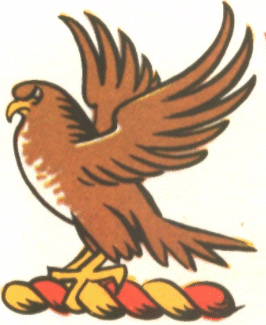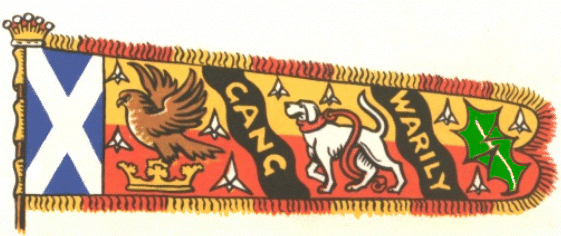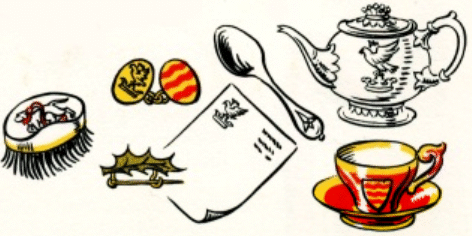

Crests and other heraldic badges
by Mike Oettle
OKAY, so we’ve established that the crest is a part of the heraldic composition, or achievement.


But it also functions as a badge, and can be one of a number of badges used by an armigerous person.
Let’s look again at the way Moncreiffe and Pottinger[1] discuss the issue:

“The crest is often depicted for convenience on the wreath alone, without the helmet, as a mark of ownership.

“In Scotland, a metal plate showing a chief’s crest and motto used to be suspended by a strap and buckle around the necks of his retainers.
“So nowadays a chief’s crest, when encircled by a strap and buckle bearing his motto, may be worn as a badge by all his staff and family or clan.


“Many chiefs have plant-badges as well, which may also be worn by their clan.
“A small shield of the arms was worn as a badge in some countries, and a number of great men have other heraldic badges – used to mark their property and to distinguish their followers.


“These badges are sometimes displayed on a background of the ‘liveries’ (usually the two principal tinctures of the shield), on a headquarters flag called the ‘standard’.
“All peers, and those Scots lairds who are territorial barons, may place a chapeau[2] above their shields – peers always put it inside their coronets.


“Mantlings are normally of the livery colours, but the Sovereign’s[3]
is gold, lined with ermine, and those of Scots peers and certain Officers of
State are red, lined with ermine.
“Certain prominent men are also allowed to depict their shields held up by ‘supporters’, which stand on a mound called a ‘compartment’.
“So the full achievement of a peer is made up of his coat of arms, chapeau, coronet, helmet, crest, mantling, motto, supporters and compartment.”

This is true, at any rate, of the arms of British peers. On the European Continent, the mantle or robe of estate – or, in the case of sovereigns, the pavilion – is an important part of the display of an important lord. (See here for an example of a mantle, here for a pavilion.) Usually lined with ermine, it hangs behind the achievement, and enough of its outside is turned, left and right, to allow the viewer to see its colour.
The pavilion is effectively a more elaborate mantle. At its topmost point is the sovereign’s crown, resting on a bell-like tent structure out of which flows the mantle.
Often, where there is no pavilion, the mantle is topped by a crown, a coronet or sometimes a special cap, and in the case of both pavilions and crowned mantles the robe is knotted on either side, so as to draw it back and display the armorial achievement more effectively.
Carl Alexander von Volborth, in his book Heraldry of the World,[4] writes:
“The origins of the robe of estate can be traced back at least to the sixteenth century. Used sometimes as an alternative to mantling, it stems perhaps from the robes of honour or office that princes and important officials wore on ceremonial occasions or from the draperies around a throne.
“The robe of estate is especially used by princes, the high aristocracy and the holders of certain important offices, but not by all in these categories.

“The outside of a robe of estate is usually purple or red, but may also be black or blue, as found at times in Sweden and France. It sometimes has a pattern of fleurs-de-lys, crowns or Napoleonic bees or repeats the charges from the arms. The inside is usually ermine, but yellow (gold) and white (silver) may also be used.”

But all this is getting pretty far away from armory as used by ordinary mortals (and Scottish peers are much more ordinary mortals than their Continental cousins). Back to Moncreiffe and Pottinger, and continuing from the last quote concerning a heraldic gentleman (Drummond, Earl of Perth):
“His heraldic emblems can be used in innumerable ways to mark his property.

“They can appear on such things as curtains, furniture, brushes, cuff-links, buttons, brooches, silver, china and writing paper.
“They are also used to identify him. Scotsmen wear their own personal crest or their chief’s crest-badge in their bonnets (chiefs add three eagle’s feathers and chieftains two).
“Livery colours are often used, especially as Racing Colours.
“He can fly his banner over his house, and on his motor car.”

To see how a coat of arms appears in different guises for different members of a family, click here.
